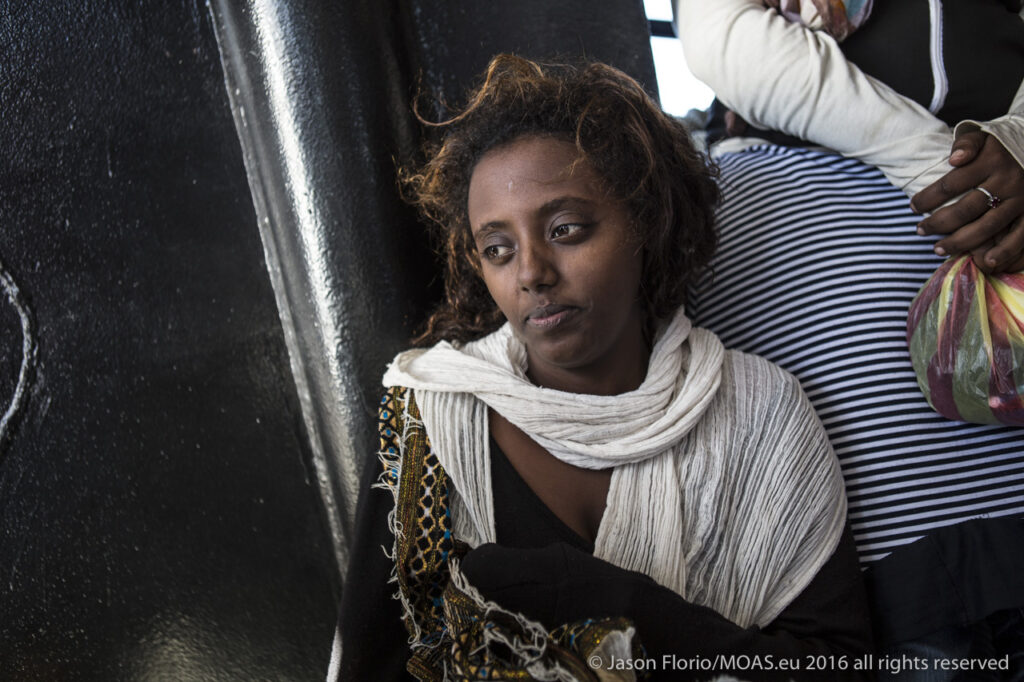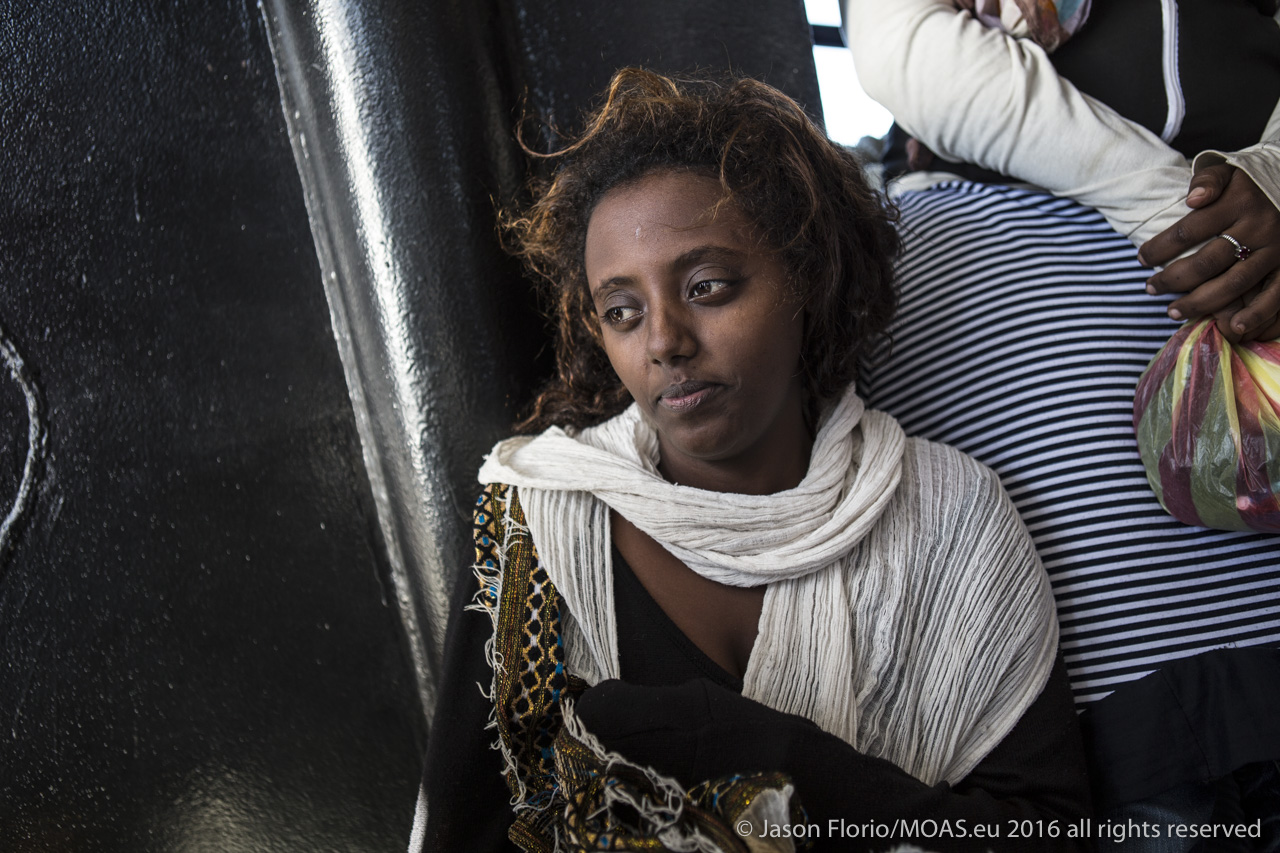23-year-old Hayat fled Eritrea after all of her family were conscripted. She was rescued by the MOAS crews during our 2016 Central Mediterranean Mission.
Throughout March, MOAS is running a special blog series exploring the reasons why people are forced to leave their homes. We will look at range of ‘push’ factors, including some that directly affect the people we rescue, as well as those that form a key component in forced migration issues more widely. In this third edition, we explore conscription and its relationship with forced migration, focusing on the Eritrean National Service and why it has led so many Eritreans to seek sanctuary beyond Eritrea’s borders.
What is conscription?
Conscription is the compulsory enrolment of people for national service, often involving military training and service. While forms of conscription in Europe and the US have been increasingly phased out since the 1960 and 70s, variations of voluntary and selective conscription are still maintained in countries throughout Eastern Europe, Northern Africa, parts of the Middle East and South America.
Although the OHCHR (the UN human rights body) recognises that conscription in itself is not a human rights violation, in some countries the abusive use of conscription has lead to serious violations of people’s rights, which in turn act as a driver for forced migration. This is especially clear in the case of Eritrea, where the ‘open-ended and arbitrary duration’ of national service, the use of conscripts as forced labour, and inhuman conditions in military camps have led hundreds of thousands of Eritreans to flee the country.
Conscription in Eritrea
Introduced in 1994, just one year after the country declared its independence from Ethiopia, the Eritrean National Service (ENS) was designed not just to bolster Eritrea’s military, but also as a way to encourage commitment among Eritrean citizens to their new nation. From the age of 18, everyone must complete 18 months of the ENS, and only veterans of the country’s 30-year war of independence – and the physically and mentally infirm – are exempt. In 2012, the government also created Hizbawi Serawit, or the ‘People’s Army’, in which people up to 70 years old are required to participate.
When the ENS was initially introduced, conscripts were expected to complete 6 months of military training and 12 months of ‘development’ work. This work could be undertaken for the Ministry of Defence or other national ministries and regional administrations. Despite the original 18-month limit, in 2002 a new obligation to perform indefinite national service was introduced. In practice, people regularly serve for over a decade, the timing of their eventual release relying on discretion of their commander.
It is estimated that around 1 in 20 Eritreans currently live in huge desert barracks, working on reconstruction projects, in agriculture, and to a lesser extent in the civil service. The OHCHR has also found that conscripts are required to work in projects that personally benefit military commanders and officials.
The conditions in which conscripts undertake this work are marked by the threat of exploitation and violence. Human Rights Watch (HRW) has reported that physical abuse and torture are frequently inflicted on conscripts, and has also found that female conscripts regularly face forced domestic servitude and sexual violence, with no possibility for redress against the perpetrators.
In 2016, the OHCHR completed a Commission of Inquiry into human rights in Eritrea, and found that the conditions of Eritrean National Service rise to the crime of enslavement. It further found that attempts to escape the draft – including conscientious objection to military service and applying for release from military service – are viewed as treason and are punished with violence and arbitrary detention.
Conscription as a cause of forced migration
At the end of 2015, the UNHCR reported that there were approximately 474,000 Eritrean refugees and asylum seekers globally, about 12 per cent of Eritrea’s official population estimate. Such a high rate of departure has been mirrored in MOAS’ experience; during our 2016 Central Mediterranean mission, the second most common country of origin among the people we rescued was Eritrea.
In line with what the people we rescue tell our crews, the OHCHR has found that conscription is the most frequently cited reason for leaving Eritrea. During interviews with Eritrean refugees, HRW found that they described the ‘catastrophic effect’ conscription has on family life as a significant push factor, as separation and the minimal pay that conscripts receive make it extremely hard to maintain and support a family. HRW further found that Eritrean refugees described the reality of indefinite conscription as making it impossible to hold any hope for a future in Eritrea, forcing people to leave the country.
While many Eritreans seek sanctuary in Ethiopia and Sudan, the conditions they face in refugee camps there – including grinding poverty and malnutrition – mean that many feel they have no choice but to entrust their lives to people smugglers and attempt the deadly journey across the Sahara to Libya, in the hope of finally reaching Europe.
Look out for this Friday’s podcast, in which we explore how conscription has affected forced migration in Syria. The next blog in the series on push factors is coming next Wednesday, and for all the MOAS news and updates sign up to our newsletter at the bottom of this page. You can support our rescue missions by giving whatever you can to help us save lives at sea.


